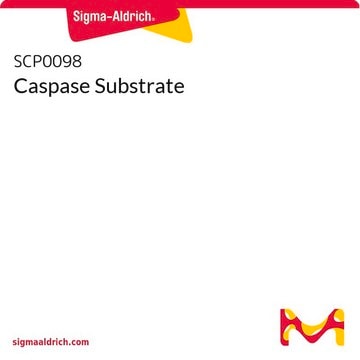推薦產品
化驗
≥98% (HPLC)
形狀
powder
顏色
white to beige
溶解度
DMSO: 2 mg/mL, clear
儲存溫度
2-8°C
InChI
1S/C24H21F6NO7/c25-23(26,27)20(24(28,29)30)38-21(32)31-7-5-13(6-8-31)22(33,14-1-3-16-18(9-14)36-11-34-16)15-2-4-17-19(10-15)37-12-35-17/h1-4,9-10,13,20,33H,5-8,11-12H2
InChI 密鑰
SXHQLPHDBLTFPM-UHFFFAOYSA-N
生化/生理作用
KML29, an O-hexafluoroisopropyl (HFIP) carbamate analogue of JZL184. is a potent and orally active monoacylglycerol lipase (monoglyceride lipase; MAGL; MGLL; MGL) inhibitor (IC50 = 5.9/15/43 nM against human/mouse/rat MAGL) that targets MAGL active site with greatly improved selectivity (rat/mouse ABHD6 IC50 = 1.60/4.87; no inhibitory activity against human/rat/mouse fatty acid amide hydrolase (FAAH) up to 50 μM). KML29 in vivo treatment results in a selective upregulation of 2-arachidonoyl glycerol (2-AG), but not N-arachidonoyl-ethanolamine (AEA) in mice (brain Emax ∼20 mg/kg p.o. or i.p.; peripheral Emax ∼1 mg/kg p.o.) and rats (brain Emax ∼40 mg/kg i.p.). KML29 reduces inflammatory and neuropathic nociceptive behaviour in animal studies without cannabimimetic side effects seen with dual FAAH & MAGL inhibition, chronic administration, however, leads to CB1 receptor desensitization as observed with other MAGL inhibitors.
儲存類別代碼
11 - Combustible Solids
水污染物質分類(WGK)
WGK 3
閃點(°F)
Not applicable
閃點(°C)
Not applicable
分析證明 (COA)
輸入產品批次/批號來搜索 分析證明 (COA)。在產品’s標籤上找到批次和批號,寫有 ‘Lot’或‘Batch’.。
Molly S Crowe et al.
British journal of pharmacology, 174(23), 4523-4539 (2017-10-01)
Gabapentin is commonly prescribed for nerve pain but may also cause dizziness, sedation and gait disturbances. Similarly, inhibition of the endogenous cannabinoid enzyme monoacylglycerol lipase (MAGL) has antinociceptive and anti-inflammatory properties but also induces sedation in mice at high doses.
Andreu Viader et al.
eLife, 5, e12345-e12345 (2016-01-19)
Metabolic specialization among major brain cell types is central to nervous system function and determined in large part by the cellular distribution of enzymes. Serine hydrolases are a diverse enzyme class that plays fundamental roles in CNS metabolism and signaling.
Sally Miller et al.
Investigative ophthalmology & visual science, 57(7), 3287-3296 (2016-06-23)
Cannabinoids, such as Δ9-THC, act through an endogenous signaling system in the vertebrate eye that reduces IOP via CB1 receptors. Endogenous cannabinoid (eCB) ligand, 2-arachidonoyl glycerol (2-AG), likewise activates CB1 and is metabolized by monoacylglycerol lipase (MAGL). We investigated ocular
B M Ignatowska-Jankowska et al.
British journal of pharmacology, 171(6), 1392-1407 (2013-07-16)
Since monoacylglycerol lipase (MAGL) has been firmly established as the predominant catabolic enzyme of the endocannabinoid 2-arachidonoylglycerol (2-AG), a great need has emerged for the development of highly selective MAGL inhibitors. Here, we tested the in vivo effects of one
Noemi Pasquarelli et al.
Neuropharmacology, 124, 157-169 (2017-04-05)
Amyotrophic lateral sclerosis (ALS) is a fatal neurodegenerative disease of the motor neuron system with limited therapeutic options. While an increasing number of ALS patients can be linked to a small number of autosomal-dominantly inherited cases, most cases are termed
我們的科學家團隊在所有研究領域都有豐富的經驗,包括生命科學、材料科學、化學合成、色譜、分析等.
聯絡技術服務








